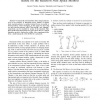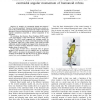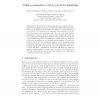9 search results - page 1 / 2 » Balance Control of a Humanoid Robot Based on the Reaction Nu... |
IROS
2006
IEEE
13 years 10 months ago
2006
IEEE
— A humanoid robot should be able to keep its balance even in the presence of disturbing forces. Studies of human body reaction patterns to sudden external forces are useful to d...
ICRA
2007
IEEE
13 years 10 months ago
2007
IEEE
Abstract— A number of conceptually simple but behaviorrich “inverted pendulum” humanoid models have greatly enhanced the understanding and analytical insight of humanoid dyna...
ICRA
2003
IEEE
13 years 9 months ago
2003
IEEE
— We present a framework for composing motor controllers into autonomous composite reactive behaviors for bipedal robots and autonomous, physically-simulated humanoids. A key con...
ROBOCUP
2005
Springer
13 years 10 months ago
2005
Springer
Abstract. In the Humanoid Leagues balancing during walking and running is still the biggest challenge for most of the teams. We present here some work in which a dynamic walker is ...
IROS
2009
IEEE
13 years 11 months ago
2009
IEEE
Abstract— We present an adaptive control approach combining forward kinematics model learning methods with the operational space control approach. This combination endows the rob...



